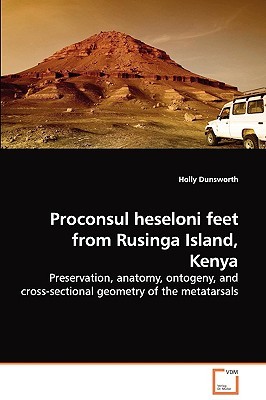
- We will send in 10–14 business days.
- Author: Holly Dunsworth
- Publisher: VDM Verlag
- ISBN-10: 3639105435
- ISBN-13: 9783639105438
- Format: 15.2 x 22.9 x 1.7 cm, softcover
- Language: English
- SAVE -10% with code: EXTRA
Proconsul heseloni feet from Rusinga Island, Kenya - Preservation, anatomy, ontogeny, and cross-sectional geometry of the metatarsals (e-book) (used book) | bookbook.eu
Reviews
Description
In the mid 1980s, teams from Johns Hopkins University and the National Museums of Kenya colleted a minimum of ten Proconsul heseloni individuals from the Kaswanga Primate Site (KPS), Rusinga Island, Kenya dating to the early Miocene. Five of them have nearly complete right and/or left feet. Because the KPS individuals died at different stages of development, their foot and hindlimb proportions through ontogeny are investigated. Dissimilarities to macaques and similarities to apes in growth patterns suggest Proconsul was not born with large feet like macaques and other non-hominoid primates. The Proconsul metatarsals were scanned with high-resolution microCT and in overall strength properties they resemble Macaca more than Pan. However, the first metatarsal of Proconsul showed greater resistance to bending and torsional forces for its length than Macaca, which is more like Pan. Overall results support previous interpretations on partial and incomplete Proconsul pedal fossils, and on other parts of the postcranial skeleton, that Proconsul was a generalized arboreal quadruped that grasped tree branches with a long, strong hallux.
EXTRA 10 % discount with code: EXTRA
The promotion ends in 18d.18:07:05
The discount code is valid when purchasing from 10 €. Discounts do not stack.
- Author: Holly Dunsworth
- Publisher: VDM Verlag
- ISBN-10: 3639105435
- ISBN-13: 9783639105438
- Format: 15.2 x 22.9 x 1.7 cm, softcover
- Language: English English
In the mid 1980s, teams from Johns Hopkins University and the National Museums of Kenya colleted a minimum of ten Proconsul heseloni individuals from the Kaswanga Primate Site (KPS), Rusinga Island, Kenya dating to the early Miocene. Five of them have nearly complete right and/or left feet. Because the KPS individuals died at different stages of development, their foot and hindlimb proportions through ontogeny are investigated. Dissimilarities to macaques and similarities to apes in growth patterns suggest Proconsul was not born with large feet like macaques and other non-hominoid primates. The Proconsul metatarsals were scanned with high-resolution microCT and in overall strength properties they resemble Macaca more than Pan. However, the first metatarsal of Proconsul showed greater resistance to bending and torsional forces for its length than Macaca, which is more like Pan. Overall results support previous interpretations on partial and incomplete Proconsul pedal fossils, and on other parts of the postcranial skeleton, that Proconsul was a generalized arboreal quadruped that grasped tree branches with a long, strong hallux.


Reviews